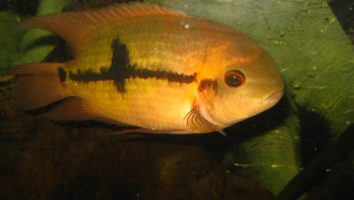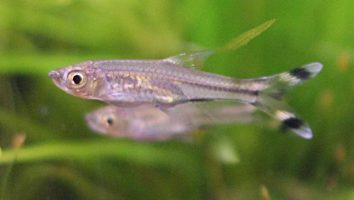The Cambodian log sucker is a very interesting and unique freshwater fish that is perfect for the beginner aquarist. They are very easy to care for and are very peaceful fish.
This guide will teach you everything you need to know about Cambodian log sucker care. You’ll learn about their diet, size, lifespan, and more!
Table of contents
Species overview
The Cambodian log sucker (Gyrinocheilus aymonieri) is a type of freshwater fish that’s native to, you guessed it, Cambodia!
These fish are most commonly found in the Mekong River basin which runs through a large portion of the country.
They prefer slow-moving waters with a lot of vegetation and hiding places. This is something that’s common to many types of bottom-dwelling fish.
The Cambodian log sucker is a very peaceful fish that does well in most community tanks. They are slow eaters so it’s important to make sure they are getting enough food.
These fish are very popular in the aquarium trade due to their unique appearance. They have a long, slender body with a whorl-like pattern on their head.
Appearance

The Cambodian log sucker is a freshwater fish that is native to, you guessed it, Cambodia!
This species has a long and thin body that is light brown in color. There are darker spots on their sides that are a bit more pronounced.
Their fins are all a light brown as well and their caudal fin is forked.
One thing that really sets this fish apart is the fact that they have two “lips”. The upper lip is very thin and almost non-existent. The lower lip is very thick and fleshy.
These lips are great for suctioning on to objects (hence the name log sucker).
Cambodian log suckers are peaceful fish that do well in community tanks. They’re not very demanding when it comes to water conditions and can even live in brackish water.
Lifespan
The lifespan of a Cambodian log sucker is typically around 3 to 5 years. However, there have been reports of them living up to 10 years in captivity.
As with most fish, their lifespan is going to depend on the quality of care they receive. Things like water quality, diet, and stress can all impact how long they live.
Size
The average size of a Cambodian log sucker is about 3-4 inches.
Tank
Tank Size
The recommended tank size for Cambodian log suckers is at least 48 inches (4 feet) in length. This is assuming you’re keeping them in a school of at least 5 fish.
Cambodian log suckers are a peaceful and relatively small species of freshwater fish. They’re a great option for beginner aquarists who want to keep a school of fish in a community tank.
Water Parameters
The Cambodian log sucker is a peaceful, bottom-dwelling fish that is native to the Mekong River Basin in Southeast Asia. In the wild, they inhabit murky waters with plenty of hiding places.
To successfully keep this species in captivity, you need to provide similar water conditions. This includes warm temperatures, slightly acidic water, and plenty of hiding places.
The ideal water parameters for the Cambodian log sucker are:
- Water Temperature: 75 to 82 degrees Fahrenheit
- pH Levels: 6.5 to 7.5
- Water Hardness: 2 to 12 dGH
- Alkalinity Levels: 4-8 dKH
What To Put In Their Tank
When it comes to setting up an aquarium for a Cambodian Log Sucker there are a few things that we recommend.
First and foremost, these fish love to hide. So, you’re going to want to include a lot of hiding places in their tank. This can be in the form of plants, rocks, driftwood, or anything else that provides cover.
The substrate in their tank can be pretty much anything. These fish aren’t fussy when it comes to the type of gravel or sand that you use.
We do recommend avoiding anything too small though. The reason being is that these fish love to sift through the substrate looking for food. If the pieces are too small they might end up ingesting them which can lead to health problems down the road.
As for plants, there are a few good options. Java Fern and Anubias are both great choices since they’re tough and can handle being buried a bit.
Common Diseases
There are a few diseases that are common in Cambodian log suckers. The most common is Hole in the Head disease, which is caused by poor water quality.
This disease is characterized by small holes that appear in the head of the fish. If left untreated, it can be fatal.
The best way to prevent this disease is to maintain high water quality in the tank. This can be done by performing regular water changes and using a good filtration system.
If you notice any holes in the head of your fish, you should immediately begin treatment. This usually involves raising the water quality and treating the fish with an antibiotic.
Another disease that these fish are susceptible to is Ich. This is a parasitic infection that is very common in freshwater fish.
It is characterized by white spots on the body, fins, and gills of the fish. If left untreated, it can be fatal.
The best way to prevent this disease is to maintain high water quality in the tank. This can be done by performing regular water changes and using a good filtration system.
If you notice any white spots on your fish, you should begin treatment immediately. This usually involves raising the water quality and treating the fish with an anti-parasitic medication.
Behavior & Temperament
The Cambodian log sucker is a peaceful fish that spends the majority of its time scavenging for food near the bottom of the tank. These fish are relatively active and love to explore their environments.
One of the most interesting things about the Cambodian log sucker is the way they reproduce. The female will lay her eggs on a hard surface, and the male will fertilize them. Once the eggs are fertilized, the female will pick them up in her mouth and incubate them until they hatch.
The fry will remain in the mother’s mouth for a few days until they are large enough to fend for themselves.
When it comes to temperament, the Cambodian log sucker is a peaceful fish that does well in community tanks. They are not aggressive and will not bother other tank mates.
Tank Mates
The Cambodian log sucker is a peaceful bottom-dwelling fish that does well in community tanks. These fish are shy and prefer to stay hidden amongst the plants and driftwood.
Because of their timid nature, it’s important to choose tank mates that won’t harass them.
Cambodian log suckers are also sensitive to water quality. They prefer well-oxygenated and clean water. As a result, it’s important to choose tank mates that won’t contribute to water pollution.
Some compatible tank mates for Cambodian log suckers include:
- Ghost shrimp
- Cherry shrimp
- Amano shrimp
- Tetras
- Guppies
- Platies
- Mollies
- Swordtails
Breeding
Cambodian log suckers are a bit different when it comes to breeding. The female doesn’t lay eggs, but rather gives birth to live young.
To get things started, you’ll need to set up a breeding tank. It should hold at least 30 gallons of water. The water should be well-filtered and have a low flow rate.
Then, add some plants and driftwood for cover. The plants are important because they give the female somewhere to hide when she’s ready to give birth.
When everything is set up, add two females for every male. The males will chase the females around, but they won’t hurt them.
Eventually, the females will be ready to give birth. You’ll know it’s about to happen when they start to get larger and their bellies turn red.
When they’re ready, the females will find a hiding spot and give birth. Each female can give birth to around 60 fry at a time.
After they’re born, it’s important to remove the adults from the tank. They will eat the fry if given the chance.
The fry are very small and need to be fed live food. You can buy live baby brine shrimp or microworms from a pet store.
Conclusion
The Cambodian Log sucker is a great fish for anyone looking for a unique addition to their tank. They’re not the easiest fish to care for, but they’re definitely not the hardest either.
As long as you’re willing to do a little bit of research and put in the effort to care for them properly, they can make a great addition to your tank.
We hope you’ve enjoyed learning a little bit more about this fish and we wish you the best of luck if you decide to add them to your tank!












